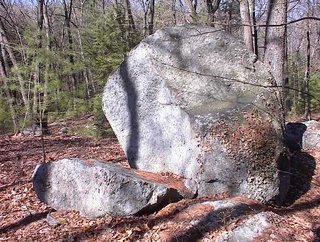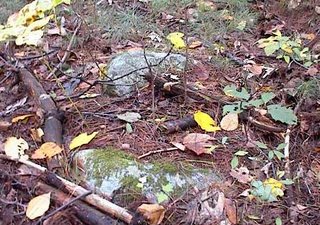 You can see the pond in the background and the outlet which is trenched out, exiting to the lower left. A rock pile seems placed deliberately here. Other rock piles occur along the shore of the pond to the right. This is in Concord.
You can see the pond in the background and the outlet which is trenched out, exiting to the lower left. A rock pile seems placed deliberately here. Other rock piles occur along the shore of the pond to the right. This is in Concord.
Sunday, April 30, 2006
Outlet to a spring fed pond
 You can see the pond in the background and the outlet which is trenched out, exiting to the lower left. A rock pile seems placed deliberately here. Other rock piles occur along the shore of the pond to the right. This is in Concord.
You can see the pond in the background and the outlet which is trenched out, exiting to the lower left. A rock pile seems placed deliberately here. Other rock piles occur along the shore of the pond to the right. This is in Concord.
Springtime in Estabrook Woods, Concord
Can you see the rock pile in this picture?
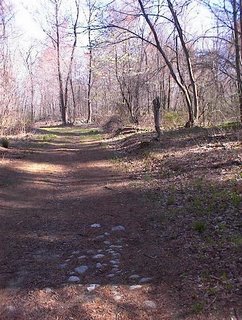 Did you guess? I think there is one underfoot on the path a few feet in front of the camera. It was a beautiful day to be out and there is finally some color coming back to the woods. So I went back to one of the few natural rock pile sites in Estabrook Woods and took a few pictures. I wanted to come before there was too much undergrowth. In fact I did see a few new piles - mostly low piles on support boulders at the edge of a wetland. This was new:
Did you guess? I think there is one underfoot on the path a few feet in front of the camera. It was a beautiful day to be out and there is finally some color coming back to the woods. So I went back to one of the few natural rock pile sites in Estabrook Woods and took a few pictures. I wanted to come before there was too much undergrowth. In fact I did see a few new piles - mostly low piles on support boulders at the edge of a wetland. This was new:
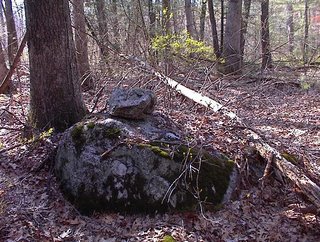 And here another from the same area. There are ten or so piles like this.
And here another from the same area. There are ten or so piles like this.
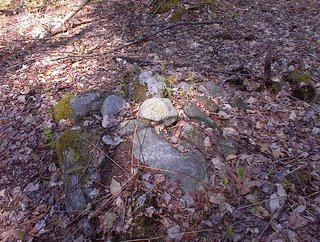
 Did you guess? I think there is one underfoot on the path a few feet in front of the camera. It was a beautiful day to be out and there is finally some color coming back to the woods. So I went back to one of the few natural rock pile sites in Estabrook Woods and took a few pictures. I wanted to come before there was too much undergrowth. In fact I did see a few new piles - mostly low piles on support boulders at the edge of a wetland. This was new:
Did you guess? I think there is one underfoot on the path a few feet in front of the camera. It was a beautiful day to be out and there is finally some color coming back to the woods. So I went back to one of the few natural rock pile sites in Estabrook Woods and took a few pictures. I wanted to come before there was too much undergrowth. In fact I did see a few new piles - mostly low piles on support boulders at the edge of a wetland. This was new: And here another from the same area. There are ten or so piles like this.
And here another from the same area. There are ten or so piles like this.
Saturday, April 29, 2006
Small Ground Piles on Oak Hill Littleton, MA
Oak Hill is a big piece of the landscape out west of here. If you drive west on Rt 2, this is the long hill you climb just west of Rt 495. I went to the backside of this hill to explore around the edges of Tophet Casm. Somewhere up there on the gradual slope of the hilltop there was a quadrangle of stone walls with eight or ten ground piles. I might think these are burials except for a couple of minor inconsistencies - mostly that the view northward and the woods here are dry. Burials are more associated to views westward and to views over water. So I think this may be a different type of site. Just low small piles covered with leaves.
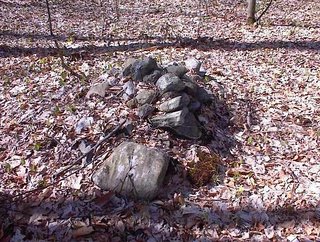
 There was one example of a supported pile. All the others were directly on the ground.
There was one example of a supported pile. All the others were directly on the ground.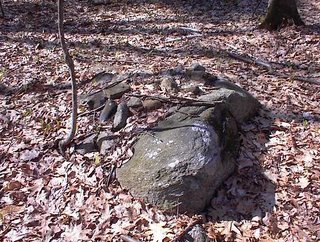


 There was one example of a supported pile. All the others were directly on the ground.
There was one example of a supported pile. All the others were directly on the ground.
Split Boulder ceremony - Oak Hill Littleton
Friday, April 28, 2006
New Mystery Hill articles - James Gage writes in.
James writes:
Two new articles on America's Stonehenge (Mystery Hill) were posted on our website.
"Merrimack River Petroglyph" - A new interpretation of the so called "running deer" petroglyph in the Oracle Chamber. http://www.stonestructures.org/html/river_petroglyph.html
"Cupule Stone" - Excavated in 1969, this cupule stone has largely been forgotten about. We recently received permission to examine and photograph the stone. http://www.stonestructures.org/html/cupule_stone.html
James Gage http://www.stonestructures.org
Two new articles on America's Stonehenge (Mystery Hill) were posted on our website.
"Merrimack River Petroglyph" - A new interpretation of the so called "running deer" petroglyph in the Oracle Chamber. http://www.stonestructures.org/html/river_petroglyph.html
"Cupule Stone" - Excavated in 1969, this cupule stone has largely been forgotten about. We recently received permission to examine and photograph the stone. http://www.stonestructures.org/html/cupule_stone.html
James Gage http://www.stonestructures.org
Snake Site, continued
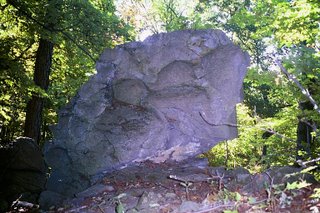
By Geophile
Let me write a little preface to another part of this story. I used to interview naturalists (no, not naturists which is another thing entirely and would no doubt make for a more visually interesting blog) for a publication I edited for a short time. After doing a number of these interviews, I noticed something--when they had given me the information I needed, we would talk amiably and then there would be a comment like "Don't tell anybody what I'm going to tell you," or "Don't print this," and then they would launch into a story of an event they experienced in nature which they regarded as extraordinary, spiritual or supernatural in some way. This happened often enough so that I began to think of it as a phenomenon in itself, maybe a mental effect generated by spending so much time out in the natural world which was the environment that shaped our minds in the first place, maybe a reflexive effect that created the illusion that something was 'out there.'
Now, as rock heads we necessarily spend a lot of time out in nature, too. So it's not too surprising that some of us have stories that seem a little flaky, stories that we hesitate to tell because they make us look unscientific. However, hiding true stories because they don't jibe with the world view we want to adhere to is a way of never getting to the whole picture. I say all this to appease those who are uncomfortable with this sort of material. Among some of the descendants of native people I've known all this explication would just be the source of a good laugh.
So here's another curious incident. First another picture of the rock ridge on the hill near the Lehigh. Sorry about the glare . . .

Same ridge from the other side, looking down the hill.
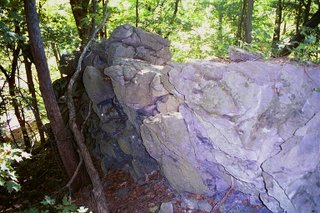 When I was there the first time, I found a tiny iridescent red feather on a flat stone there. An odd thing to notice, something so tiny. It could only have been a throat feather from a ruby-throated hummingbird.
When I was there the first time, I found a tiny iridescent red feather on a flat stone there. An odd thing to notice, something so tiny. It could only have been a throat feather from a ruby-throated hummingbird.Here's the rock ridge front-on, with the head facing us.
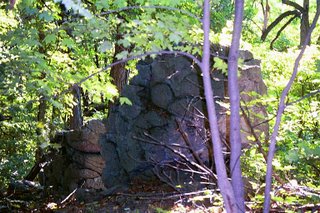 After this second time I went, when I took pictures, got stung and banned from the property, and then was told off, I was home doing the dishes when I saw what looked like a maple leaf on the lawn after a rain. As I did the dishes, I became less and less sure it was a leaf. When I went out to check, I found a hummingbird, a juvenile male, spread out on the grass but alive. I had a feeder, so I brought him in to keep him safe for the night and give him a chance to revive. I put a screen over the box we kept him in. Here he is. Pictures of him make up the rest of the roll I took at that site.
After this second time I went, when I took pictures, got stung and banned from the property, and then was told off, I was home doing the dishes when I saw what looked like a maple leaf on the lawn after a rain. As I did the dishes, I became less and less sure it was a leaf. When I went out to check, I found a hummingbird, a juvenile male, spread out on the grass but alive. I had a feeder, so I brought him in to keep him safe for the night and give him a chance to revive. I put a screen over the box we kept him in. Here he is. Pictures of him make up the rest of the roll I took at that site.
In the morning, I put him out on the feeder in the open box. When I came home from work he was gone.
I won't try to interpret it into something understandable. Peter says hummingbirds have significance in Indian lore, and a quick search on Google brings up a smorgasbord of tales and meanings that I hesitate to dip my toes into.
All I'll say is, it felt like a little grace, being allowed to serve. But I know that's not rational . . .
But maybe this was a little like the way the originators of these sites experienced the stones.
Of Wasps and Snakes
By Geophile
Peter invited me to post this here, despite the subjective nature of parts of it.
I took these pictures during my one indiscretion of visiting a privately-owned site without permission, some years ago. This site had been important to my change from skeptic to believer in the concept that there were indeed unexplained stonework sites out there, and I wanted to go back to get pictures of it. I was having difficulty getting anyone with permission to take me back, so I went there with a friend who was curious.
This one indiscretion resulted in my being stung 70 times by yellow jackets and being caught by the irate property owner (after the stings) and then later being told off in no uncertain terms by the person who first showed me the site. I have never done something like that again.
Along with all that, the pictures turned out kind of peculiar and hardly captured the vision that first arrested me. Nevertheless, here are some of them, photos of a rock ridge running up the side of a hill by the Lehigh River.
It's an odd ridge of rock, narrow and high running straight up a hill that has no similar features.
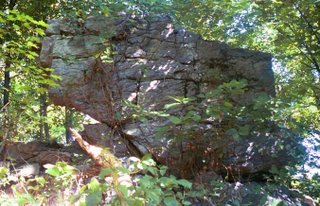 The rocks that make it up are peculiar and bumpy in some areas, like no other rocks I've seen in our area.
The rocks that make it up are peculiar and bumpy in some areas, like no other rocks I've seen in our area.
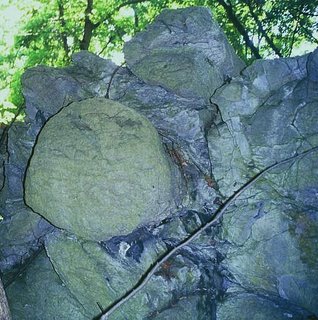
Nearby on the ground, I found this very unusual carved-looking stone. Or maybe it was something else? Cement that looked like stone? I've never seen anything like it.
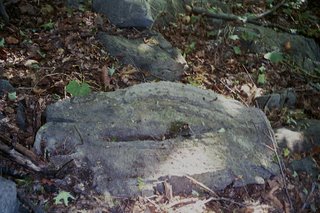 Here's a view along the top of the rock ridge looking down the hill toward the road and the stream that runs along it.
Here's a view along the top of the rock ridge looking down the hill toward the road and the stream that runs along it.
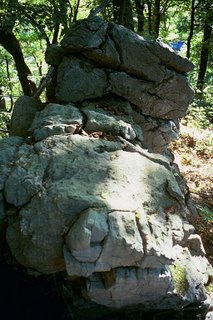
More of the rock ridge with a gap before the top part . . .
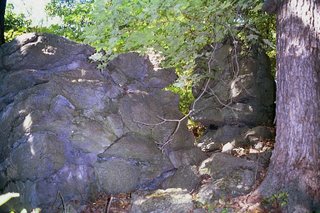 And here's the kicker--at the top end of the rock ridge is the stone below. It is taller than I am (the whole ridge is, all the way up) and it looks startlingly like a reptile head, (turtle? maybe snake because of the long ridge behind it) complete with eye and with the mouth open as if for offerings. The peculiar colors in some of these photos must be a result of the light and shadow in that place on that day. I have more of these odd purplish-blue rock pictures from there, including another of this stone head. It was while walking back down the hill from here that I stepped in the yellow jacket nest, an experience I will always remember.
And here's the kicker--at the top end of the rock ridge is the stone below. It is taller than I am (the whole ridge is, all the way up) and it looks startlingly like a reptile head, (turtle? maybe snake because of the long ridge behind it) complete with eye and with the mouth open as if for offerings. The peculiar colors in some of these photos must be a result of the light and shadow in that place on that day. I have more of these odd purplish-blue rock pictures from there, including another of this stone head. It was while walking back down the hill from here that I stepped in the yellow jacket nest, an experience I will always remember.
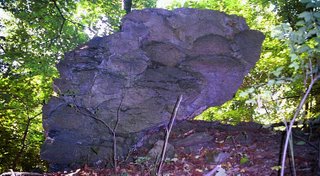
Another odd thing from that day was this picture. It's just a trick of leaves and light, and I didn't see it as anything but a rock when I took it, but the impression of a face is hard to ignore.

In short, although I am reluctant to attribute to the sites any supernatural qualities of an eerie type, this was one of the days about which I will always have doubts. I guess we all have those, and maybe we all need them.
The circumstances of my first visit there were also memorable, but humorous, and then almost giddy as the site of this rock formation cracked open my head, allowing a new understanding to enter.
Peter invited me to post this here, despite the subjective nature of parts of it.
I took these pictures during my one indiscretion of visiting a privately-owned site without permission, some years ago. This site had been important to my change from skeptic to believer in the concept that there were indeed unexplained stonework sites out there, and I wanted to go back to get pictures of it. I was having difficulty getting anyone with permission to take me back, so I went there with a friend who was curious.
This one indiscretion resulted in my being stung 70 times by yellow jackets and being caught by the irate property owner (after the stings) and then later being told off in no uncertain terms by the person who first showed me the site. I have never done something like that again.
Along with all that, the pictures turned out kind of peculiar and hardly captured the vision that first arrested me. Nevertheless, here are some of them, photos of a rock ridge running up the side of a hill by the Lehigh River.
It's an odd ridge of rock, narrow and high running straight up a hill that has no similar features.
 The rocks that make it up are peculiar and bumpy in some areas, like no other rocks I've seen in our area.
The rocks that make it up are peculiar and bumpy in some areas, like no other rocks I've seen in our area.
Nearby on the ground, I found this very unusual carved-looking stone. Or maybe it was something else? Cement that looked like stone? I've never seen anything like it.
 Here's a view along the top of the rock ridge looking down the hill toward the road and the stream that runs along it.
Here's a view along the top of the rock ridge looking down the hill toward the road and the stream that runs along it.
More of the rock ridge with a gap before the top part . . .
 And here's the kicker--at the top end of the rock ridge is the stone below. It is taller than I am (the whole ridge is, all the way up) and it looks startlingly like a reptile head, (turtle? maybe snake because of the long ridge behind it) complete with eye and with the mouth open as if for offerings. The peculiar colors in some of these photos must be a result of the light and shadow in that place on that day. I have more of these odd purplish-blue rock pictures from there, including another of this stone head. It was while walking back down the hill from here that I stepped in the yellow jacket nest, an experience I will always remember.
And here's the kicker--at the top end of the rock ridge is the stone below. It is taller than I am (the whole ridge is, all the way up) and it looks startlingly like a reptile head, (turtle? maybe snake because of the long ridge behind it) complete with eye and with the mouth open as if for offerings. The peculiar colors in some of these photos must be a result of the light and shadow in that place on that day. I have more of these odd purplish-blue rock pictures from there, including another of this stone head. It was while walking back down the hill from here that I stepped in the yellow jacket nest, an experience I will always remember.
Another odd thing from that day was this picture. It's just a trick of leaves and light, and I didn't see it as anything but a rock when I took it, but the impression of a face is hard to ignore.

In short, although I am reluctant to attribute to the sites any supernatural qualities of an eerie type, this was one of the days about which I will always have doubts. I guess we all have those, and maybe we all need them.
The circumstances of my first visit there were also memorable, but humorous, and then almost giddy as the site of this rock formation cracked open my head, allowing a new understanding to enter.
Thursday, April 27, 2006
Site behind Carlisle Insititute
Down in the swampy lowlands north of the Carlisle Institute are a few rock-on-rocks, a few ground piles with large rock components, a few rock piles on support boulders. Tim Fohl found this site and also found an interesting stone wall with a rectangular hook at one end and a curved segment at the other. It was hard to photograph. I don't have a clue what kind of site this is or what kind of piles these are, although the supported ones are pretty typical. Being mixed together this makes for a complex heterogeneous site, possibly built at different times. Examples of the ground piles with large component rocks are in the backgrounds behind the people below. Here are some of the rock piles on support boulders.
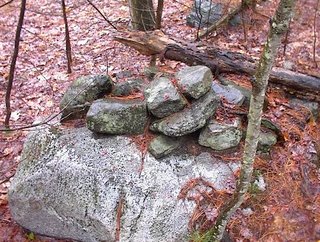
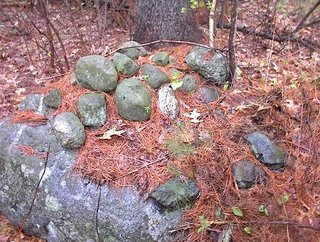 See the quartz "blaze" on that last one?
See the quartz "blaze" on that last one?
Let's leave it at that. Tomorrow should be a blank and then Saturday maybe there will be more to report.


 See the quartz "blaze" on that last one?
See the quartz "blaze" on that last one?Let's leave it at that. Tomorrow should be a blank and then Saturday maybe there will be more to report.
Some rock pile people
We had a little conference in Carlisle to talk about rock piles and alignments. Then we took a short walk to look at some piles Tim Fohl found behind the building where we were meeting. This was an occasion for me to get some photos of some of the people studying rock piles. I hope they do not mind being mentioned publicly, so here goes:
This is Doug Harris, a Narragansett Indian Tribal Preservation Officer. Doug is leading the way in creating a shared preservation goal between the Indians and the local towns. Doug is the author of the important USET resoluton 2003:022

Next is a picture of Tim Fohl (with the yellow hat) and my friend from Carlisle who doesn't want his name used. Tim has taken a lead in the Town of Carlisle, getting the town to purchase a piece of land and subsequently working to keep the town on the right track for preserving the ceremonial stone structures there.
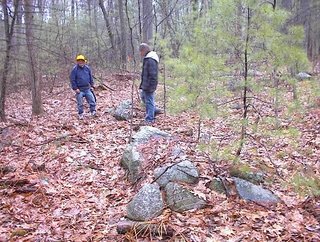 And here is me - taken by Bruce McAleer when we were west of Quabbin.
And here is me - taken by Bruce McAleer when we were west of Quabbin.
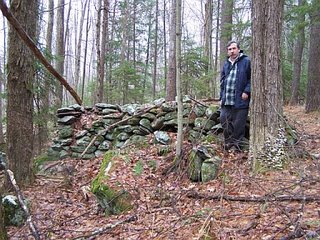 Now I have to go find a picture of Bruce.
Now I have to go find a picture of Bruce.
OK. From left to right here is Norman Muller, his wife, Ted Ballard (author of articles on stone "U"s and NEARA board member), with Bruce on the right. Norman started publishing about rock piles around the same time I did, in the late 1990's and we have been correspondents since then. Bruce began finding huge rock piles sites a couple of years ago and has a knack for finding interesting rock pile sites.
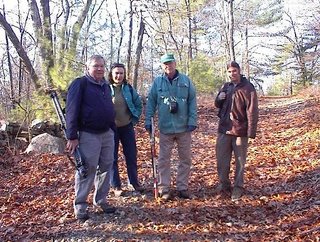 I'll add some information about the rock pile site behind the Carlisle Institute, in a moment.
I'll add some information about the rock pile site behind the Carlisle Institute, in a moment.
This is Doug Harris, a Narragansett Indian Tribal Preservation Officer. Doug is leading the way in creating a shared preservation goal between the Indians and the local towns. Doug is the author of the important USET resoluton 2003:022

Next is a picture of Tim Fohl (with the yellow hat) and my friend from Carlisle who doesn't want his name used. Tim has taken a lead in the Town of Carlisle, getting the town to purchase a piece of land and subsequently working to keep the town on the right track for preserving the ceremonial stone structures there.
 And here is me - taken by Bruce McAleer when we were west of Quabbin.
And here is me - taken by Bruce McAleer when we were west of Quabbin. Now I have to go find a picture of Bruce.
Now I have to go find a picture of Bruce.OK. From left to right here is Norman Muller, his wife, Ted Ballard (author of articles on stone "U"s and NEARA board member), with Bruce on the right. Norman started publishing about rock piles around the same time I did, in the late 1990's and we have been correspondents since then. Bruce began finding huge rock piles sites a couple of years ago and has a knack for finding interesting rock pile sites.
 I'll add some information about the rock pile site behind the Carlisle Institute, in a moment.
I'll add some information about the rock pile site behind the Carlisle Institute, in a moment.
Prehistoric field clearing piles
Here is a new one. Still blaming farmers and trivializing the rock piles, but now allowing that the farmers were pre-historic Indians. Another twist...another turn.
[Click here]
[Click here]
Georgia developers vs Rock Pile preservation activists
From Atlantaloafing.com [Click here for the whole article]
"Summertown residents hoping to invoke the law focused a last-ditch effort on what they believe are Native American burial mounds on the Deshong Crossing property.
But Garrow's survey concluded that the rock piles in question likely were placed there by farmers. While Rutherford acknowledges there are more recent rock piles on the property, she questions whether the survey even reviewed the spots neighbors believe to be burial mounds.
"There is a stone mound 10 meters long by 5 meters wide and 1-1/2 meters high back there, and it is situated up on a slope. ..." "
"Summertown residents hoping to invoke the law focused a last-ditch effort on what they believe are Native American burial mounds on the Deshong Crossing property.
But Garrow's survey concluded that the rock piles in question likely were placed there by farmers. While Rutherford acknowledges there are more recent rock piles on the property, she questions whether the survey even reviewed the spots neighbors believe to be burial mounds.
"There is a stone mound 10 meters long by 5 meters wide and 1-1/2 meters high back there, and it is situated up on a slope. ..." "
Wednesday, April 26, 2006
Giving a talk tonight (Wednesday)
The Acton Land Stewards asked me to give a slide show. So if you are near Acton and feel like driving to the Library to listen, it starts at 7:30. Here is the blurb:
Acton's Land Stewardship wishes to remind you of our upcoming lecture tomorrow."Native American Rock Piles in Middlesex County"- A slideshow discussion by Peter Waksman, presented by Acton's Land Stewardship Committee Wednesday, April 26th, 7:30pm Acton Memorial Library 484 Main St, Acton MA
The forests in Acton and surrounding communities have many secrets and untold histories.Frequently going unnoticed, clusters of rock piles riddle the woods of Acton and beyond. Some are obviously the results of field clearing. However, others are possibly Native American graves or ceremonial structures. This talk will describe the variety of these rock structures and their historic origin and distribution throughout Acton in order to provide a context for what is increasingly believed to be an outstanding historic and prehistoric resource. Hope to see you there, Philip KeyesActon Land Stewardship Committee 978-263-0459
Acton's Land Stewardship wishes to remind you of our upcoming lecture tomorrow."Native American Rock Piles in Middlesex County"- A slideshow discussion by Peter Waksman, presented by Acton's Land Stewardship Committee Wednesday, April 26th, 7:30pm Acton Memorial Library 484 Main St, Acton MA
The forests in Acton and surrounding communities have many secrets and untold histories.Frequently going unnoticed, clusters of rock piles riddle the woods of Acton and beyond. Some are obviously the results of field clearing. However, others are possibly Native American graves or ceremonial structures. This talk will describe the variety of these rock structures and their historic origin and distribution throughout Acton in order to provide a context for what is increasingly believed to be an outstanding historic and prehistoric resource. Hope to see you there, Philip KeyesActon Land Stewardship Committee 978-263-0459
Tuesday, April 25, 2006
Rt 202 Final Summary
So for two different days of driving along Rt 202, mostly in New Salem MA, we have about six rock piles sites.
- The first one north of Moosehorn Rd, including one cluster of large platform piles and separate clusters of ground piles and of gridden marker piles. I think this is several different sites in the same vicinity.
- A site where the open view shows the valley to the east with crossed pairs and rock-on-rocks.
- The Freeman Rd site with effigies or are they just walls and piles? Also supported piles and an outline.
- Cooleyville Rd - a gridded marker pile site with a large platform at the lower end of the site.
- The minor field clearing [?] piles beside the road and next to a brook.
- A minor site in a wetland on the bend of Prescott Rd.
- Gate XX where the wonderful "turtle" occurs along with clusters of supported piles at the brookside.
Pocono site revisited
By Geophile
Okay. I still have photos to post from a few sites I visited years ago--I have dial-up and uploading takes a long time--, but on Easter I revisited one, the cairn field in Monroe County. As you might expect, some of it has been destroyed. As many as twenty of the rock piles are gone, mostly to make room for a driveway. To the credit of the property owners, though, they let a few stand that they could just have removed, and the ones across the street remain.
The first two pictures below, maybe the first three, are rock piles I have posted before. I took the new pictures to show features that weren't clear before. On the first, you see the back slopes of the mountain that Camelback Ski Area is on on the background. And if you click on and enlarge the picture, you should be able to see the red stones built into this one: one on the bottom right, and a few in a layer about half way up on the left side. Note the stones in front of the pile, too. Yes, this is the same one I showed before with the niche in it.
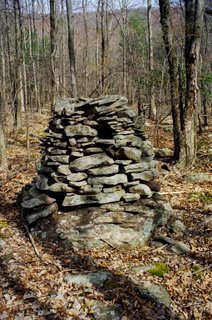
Same pile, different side. Here you can see the low wall and another rock pile behind it. This pile is not really visible from the road. It's my favorite. I was happy to see it again.
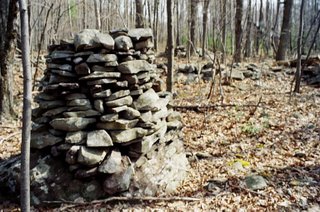
A low but artistic pile nearby. Love the way they're built on the boulders.

Looking toward the road you see more piles, probably collapsed from a more organized form.
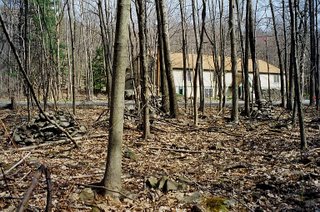
This is further down the road from the cairn field. A neat little area, from which a wall continues off to the left. Hints of femininity here, I thought, and not just in the stones, but maybe I'm too imaginative.
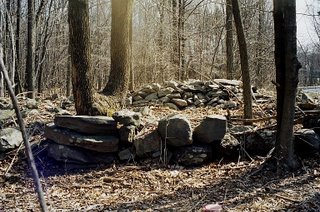
As we drove around the area, we saw more walls, more piles, some very large but not as organized. I hope to get back up there in late May to look around more. My son will be home from college, and I'm doing what I can to brainwash him.
We saw a marsh hawk, a.k.a. harrier twice hanging around near that first rock pile, and a red squirrel on the wall near the last picture. There's a huge old oak along the road, too. I'll bet it's close to three hundred years old. Oaks grow slowly, and this was one of the slower growing species. A nice place to visit.
Okay. I still have photos to post from a few sites I visited years ago--I have dial-up and uploading takes a long time--, but on Easter I revisited one, the cairn field in Monroe County. As you might expect, some of it has been destroyed. As many as twenty of the rock piles are gone, mostly to make room for a driveway. To the credit of the property owners, though, they let a few stand that they could just have removed, and the ones across the street remain.
The first two pictures below, maybe the first three, are rock piles I have posted before. I took the new pictures to show features that weren't clear before. On the first, you see the back slopes of the mountain that Camelback Ski Area is on on the background. And if you click on and enlarge the picture, you should be able to see the red stones built into this one: one on the bottom right, and a few in a layer about half way up on the left side. Note the stones in front of the pile, too. Yes, this is the same one I showed before with the niche in it.

Same pile, different side. Here you can see the low wall and another rock pile behind it. This pile is not really visible from the road. It's my favorite. I was happy to see it again.

A low but artistic pile nearby. Love the way they're built on the boulders.

Looking toward the road you see more piles, probably collapsed from a more organized form.

This is further down the road from the cairn field. A neat little area, from which a wall continues off to the left. Hints of femininity here, I thought, and not just in the stones, but maybe I'm too imaginative.

As we drove around the area, we saw more walls, more piles, some very large but not as organized. I hope to get back up there in late May to look around more. My son will be home from college, and I'm doing what I can to brainwash him.
We saw a marsh hawk, a.k.a. harrier twice hanging around near that first rock pile, and a red squirrel on the wall near the last picture. There's a huge old oak along the road, too. I'll bet it's close to three hundred years old. Oaks grow slowly, and this was one of the slower growing species. A nice place to visit.
Turtle-like pile from Freeman Rd off Rt 202
This is Bruce McAleer's photo: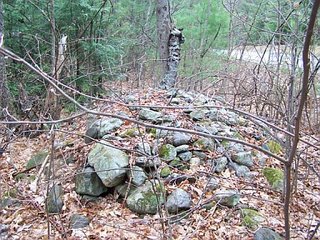 Bruce pulled the car to a stop and I said: "this is too flat for rock piles". This rock pile was right next to the car at the edge of the road where we stopped. It looks a little like a turtle, a little like a field clearing pile. Because of its nearness to other piles it is probably is not simply from field clearing.
Bruce pulled the car to a stop and I said: "this is too flat for rock piles". This rock pile was right next to the car at the edge of the road where we stopped. It looks a little like a turtle, a little like a field clearing pile. Because of its nearness to other piles it is probably is not simply from field clearing.
We walked into the woods and found a number of very nice piles besides the elongated ones I mentioned here. For example these nice ones under the hemlocks.
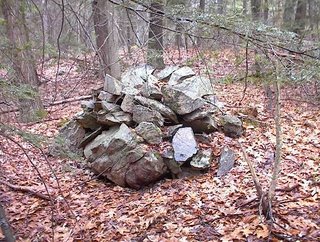
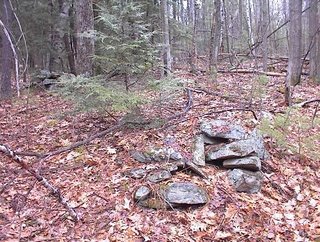 Also this rather unusual oval outline or rocks:
Also this rather unusual oval outline or rocks:
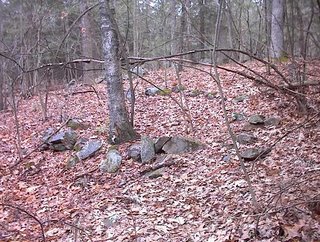 This site led from the flat to the spring to the slope, seen in the previous photo. And then along the level shoulder.
This site led from the flat to the spring to the slope, seen in the previous photo. And then along the level shoulder.
 Bruce pulled the car to a stop and I said: "this is too flat for rock piles". This rock pile was right next to the car at the edge of the road where we stopped. It looks a little like a turtle, a little like a field clearing pile. Because of its nearness to other piles it is probably is not simply from field clearing.
Bruce pulled the car to a stop and I said: "this is too flat for rock piles". This rock pile was right next to the car at the edge of the road where we stopped. It looks a little like a turtle, a little like a field clearing pile. Because of its nearness to other piles it is probably is not simply from field clearing.We walked into the woods and found a number of very nice piles besides the elongated ones I mentioned here. For example these nice ones under the hemlocks.

 Also this rather unusual oval outline or rocks:
Also this rather unusual oval outline or rocks: This site led from the flat to the spring to the slope, seen in the previous photo. And then along the level shoulder.
This site led from the flat to the spring to the slope, seen in the previous photo. And then along the level shoulder.
Monday, April 24, 2006
Elongated Piles, Freemand Rd off Rt 202 New Salem, MA
Another site along Rt 202, New Salem
A rock pile quality rating system
Sometimes it is fun to play with finding words to express how excellent a certain region is for exploring, and also try to find words for how some piles are really well done and beautiful. One ranking is in terms of how disappointed you might get while exploring in one place or another. For example Boxborough never disappoints, and same for Harvard. But south of the river in Concord rates as "almost always disappoints". Meanwhile for rock piles, we came up with an "in your face" classification if a pile is so good that it embarrases people. I have to say that many of those Pennsylvanian piles are "in your face" but so was that great pile from this weekend. More seriously, if a find is "minor" that means it is barely worth mentioning.
So here is a pretty "in your face" pile, downhill from a marker pile site.
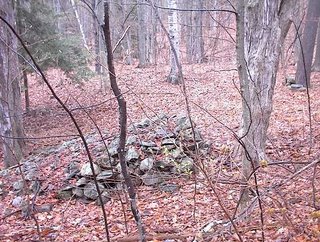 Could this be the viewing platform? Could this be the place you stand and look uphill? A large platform pile at the lower end of a marker pile site is something I've seen before.
Could this be the viewing platform? Could this be the place you stand and look uphill? A large platform pile at the lower end of a marker pile site is something I've seen before.
So here is a pretty "in your face" pile, downhill from a marker pile site.
 Could this be the viewing platform? Could this be the place you stand and look uphill? A large platform pile at the lower end of a marker pile site is something I've seen before.
Could this be the viewing platform? Could this be the place you stand and look uphill? A large platform pile at the lower end of a marker pile site is something I've seen before.Minor roadside attractions out west of Quabbin
Driving south on Rt 202 in New Salem and taking the occasional side road, there is plenty to see. Here are a couple of the minor sights (not necessarily sites) from along there.
Then somewhere along Rt 202 near some houses and fields, there were several piles next to a brook.
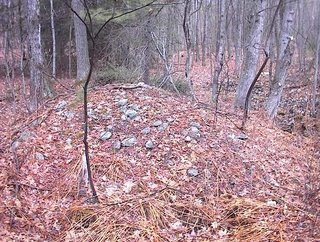 These could be from field clearing.
These could be from field clearing.
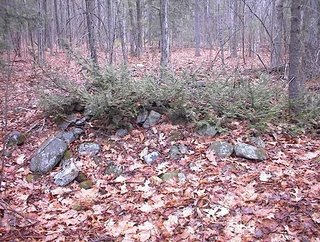 But then there is some sentiment being expressed by putting this in the middle on top:
But then there is some sentiment being expressed by putting this in the middle on top:
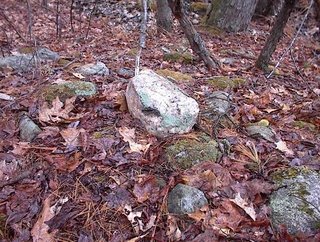 One of the piles was so close to the road and so scrofulous I couldn't bring myself to photo it.
One of the piles was so close to the road and so scrofulous I couldn't bring myself to photo it.
One is along Prescott Rd, at the bend with a swamp inside the bend, not far from Freeman Rd. I only took one picture just to record it. A wet area with a wall and perhaps three piles: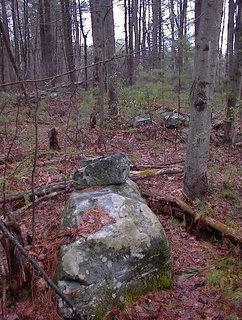
***********************************************
 These could be from field clearing.
These could be from field clearing. But then there is some sentiment being expressed by putting this in the middle on top:
But then there is some sentiment being expressed by putting this in the middle on top: One of the piles was so close to the road and so scrofulous I couldn't bring myself to photo it.
One of the piles was so close to the road and so scrofulous I couldn't bring myself to photo it.
Subscribe to:
Comments
(
Atom
)
